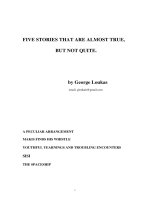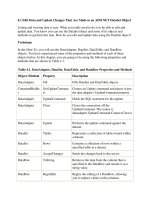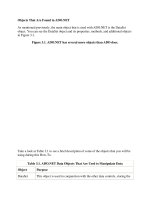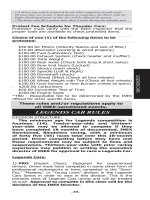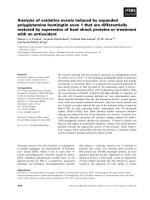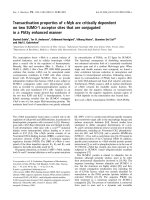Course OverviewThe course covers techniques that are useful when combined with the appropriate technical knowledge, for making engineeringeconomic decisions Such decisions are typical of those made by business firms, governmentowned enterprises and agenc
Bạn đang xem bản rút gọn của tài liệu. Xem và tải ngay bản đầy đủ của tài liệu tại đây (76.84 KB, 37 trang )
ECE 307 – Techniques for Engineering
Decisions
Course Overview
George Gross
Department of Electrical and Computer Engineering
University of Illinois at Urbana-Champaign
ECE 307 © 2005 - 2009 George Gross, University of Illinois at Urbana-Champaign, All Rights Reserved.
1
SCOPE OF COURSE
The course covers techniques that are useful when
combined with the appropriate technical
knowledge, for making engineering/economic
decisions
Such decisions are typical of those made by
business firms, government-owned enterprises
and agencies and individuals
We focus on the systematic evaluation of
alternatives before a decision is made regarding a
particular problem
ECE 307 © 2005 - 2009 George Gross, University of Illinois at Urbana-Champaign, All Rights Reserved.
2
EXAMPLES OF DECISION MAKING
PROBLEMS
Introduction of a new product
Expansion of production facilities/warehousing
Adoption of new technology
Implementation of a new production schedule
Changes in the production mix
Risk management in purchase/sale activities
Optimal scheduling of processes/projects
ECE 307 © 2005 - 2009 George Gross, University of Illinois at Urbana-Champaign, All Rights Reserved.
3
BASIC THRUSTS
Development of the analytical framework for
decision making on a sound and systematic basis
with the goal to enable the decision maker to
undertake an appropriate analysis and systematic
evaluation of various alternatives
Provide training for engineers to play an
increasingly more prominent role in the decision
making processes in their work environment
ECE 307 © 2005 - 2009 George Gross, University of Illinois at Urbana-Champaign, All Rights Reserved.
4
THE UNDERLYING BASIS
Decisions are made by selecting from possible
alternatives with reference to the future which is
inherently uncertain
A common basis is set up by formulating the
decisions in economic terms
A key aspect is the assumptions introduced to
enable the undertaking of the analysis and the
evaluation of alternatives
ECE 307 © 2005 - 2009 George Gross, University of Illinois at Urbana-Champaign, All Rights Reserved.
5
PRODUCT MIX OPTIMIZATION
PROBLEM
A factory manufactures three different products
requiring various levels of resources and
providing different benefits (profits)
The constraints on resources are given
Problem: determine the optimal daily mix, i.e., the
production schedule that maximizes profits
without violating any constraints
ECE 307 © 2005 - 2009 George Gross, University of Illinois at Urbana-Champaign, All Rights Reserved.
6
PRODUCT MIX OPTIMIZATION
PROBLEM
resources required per
unit of product
product
A
B
C
limit
labor (h)
1
1
1
100
material (lb)
10
4
5
600
A&G (h)
2
2
6
300
10
6
4
profits per unit of product ($)
ECE 307 © 2005 - 2009 George Gross, University of Illinois at Urbana-Champaign, All Rights Reserved.
7
PRODUCT MIX OPTIMIZATION
PROBLEM
We formulate the decision problem by introducing
the decision variables:
xi = daily production level of product i, i = A, B, C
We construct a programming problem for the
schedule by expressing
the objective function
the constraints
the common sense requirements
in mathematical terms
ECE 307 © 2005 - 2009 George Gross, University of Illinois at Urbana-Champaign, All Rights Reserved.
8
PRODUCT MIX OPTIMIZATION
PROBLEM
max Z = 10 x A + 6 xB + 4 xC objective
xA +
xB +
⎫
⎪
≤ 600 A & G ⎪
⎬
≤ 300 material ⎪
⎪
≥ 0 reality check ⎭
xC ≤ 100
4 x B + 5 xC
2 xA +
2 x B + 6 xC
x A , x B , xC
ECE 307 © 2005 - 2009 George Gross, University of Illinois at Urbana-Champaign, All Rights Reserved.
constraints
10 x A +
labor
9
PRODUCT MIX OPTIMIZATION
PROBLEM
The optimal solution is
x A* = 33.33
x B* = 66.67
xC* = 0
corresponding to maximum profits
Z * = $ 733.33
The shadow prices corresponding to the
constraints give the change in profits for
additional resources:
labor : $ 3.33
material : $ 0.67
A&G : $ 0
ECE 307 © 2005 - 2009 George Gross, University of Illinois at Urbana-Champaign, All Rights Reserved.
10
PRODUCT MIX OPTIMIZATION
PROBLEM
We next examine a sensitivity case corresponding
to the use of overtime labor
We are interested in determining how many
overtime hours would be profitable to schedule
without impacting on the optimal product mix
20 hours of labor overtime increases profits
by (20) (3.33) = $ 66.6
as long as the cost of overtime labor does not
exceed $ 66.6 it is worthwhile to use it
the optimal product mix remains unchanged:
since we only produce products A and B and
no product C
ECE 307 © 2005 - 2009 George Gross, University of Illinois at Urbana-Champaign, All Rights Reserved.
11
OPTIMAL TRAJECTORY PLANNING
Mr. Jones has to travel from a fixed starting point
A to a fixed destination point J with a choice in
the intermediate points he goes through
B
E
H
A
C
J
F
I
D
G
stage 1
stage 2
stage 3
stage 4
ECE 307 © 2005 - 2009 George Gross, University of Illinois at Urbana-Champaign, All Rights Reserved.
12
OPTIMAL TRAJECTORY PLANNING
The relative “costs” for the various possible
paths are given by
E F G
B C D
A 2
4
3
H
I
B
7
4
6
E
1
4
C
3
2
4
F
6
3
D 4
1
5
G 3
3
J
H
3
I
4
The problem is to select the route that minimizes
the total costs of the trip
ECE 307 © 2005 - 2009 George Gross, University of Illinois at Urbana-Champaign, All Rights Reserved.
13
OPTIMAL TRAJECTORY PLANNING
Solution approaches:
enumerate all possibilities: this is, in general,
too time consuming since we need to consider
3 × 3 × 2 = 18
different routes for this simple case
select the best for each successive stage:
myopic decision making solution leads to the
path
A
B
F
I
J
with costs of 13
ECE 307 © 2005 - 2009 George Gross, University of Illinois at Urbana-Champaign, All Rights Reserved.
14
OPTIMAL TRAJECTORY PLANNING
use some heuristic approach which allows to
sacrifice a little at one stage in the hope of
attaining savings thereafter: for example, the
path A
D
F has costs of 4 which are less
than those of the path A
B
F, which are 6
The optimal route is
A
C
E
H
J
with costs of 11
ECE 307 © 2005 - 2009 George Gross, University of Illinois at Urbana-Champaign, All Rights Reserved.
15
OPTIMAL TRAJECTORY PLANNING
There are two additional routes whose costs are
11:
A
D
E
H
J
A
D
F
I
J
Thus, this problem does not result in a unique
optimum
ECE 307 © 2005 - 2009 George Gross, University of Illinois at Urbana-Champaign, All Rights Reserved.
16
BUSING PROBLEM
Three school districts in Busville have a
distribution of Caucasians (C ) and African Americans
( A) as shown in the table
district
1
2
3
number of students
C
210
210
180
A
120
30
150
ECE 307 © 2005 - 2009 George Gross, University of Illinois at Urbana-Champaign, All Rights Reserved.
17
BUSING PROBLEM
Implementation of the Supreme Court ruling on
racial balance requires that each of the three
districts have exactly 300 students with identical
racial make-up, i.e., that
⎛ A⎞
⎛ A⎞
⎛ A⎞
⎜C⎟ = ⎜C⎟ = ⎜C⎟
⎝ ⎠1
⎝ ⎠2
⎝ ⎠3
and the only means of attaining the racial balance
goal is through busing
ECE 307 © 2005 - 2009 George Gross, University of Illinois at Urbana-Champaign, All Rights Reserved.
18
BUSING PROBLEM
Given the distances between the districts,
determine the total minimum distance that
students must be bussed to satisfy the racial
balance requirements
district
1
2
3
number of students
C
210
210
180
A
120
30
150
distance to district
2
3
—
4
3
5
4
—
ECE 307 © 2005 - 2009 George Gross, University of Illinois at Urbana-Champaign, All Rights Reserved.
19
THE ENVELOPE QUESTION
On a television game show, the host subjects
contestants to unusual tests of mental skill
On one, a contestant may choose one of two
identical envelopes – labeled A and B – each of
which contains an unknown amount of money
The host reveals, though, that one envelope
contains twice as much money as the other
After choosing A, the host suggests that the
contestant might want to switch; the host states:
ECE 307 © 2005 - 2009 George Gross, University of Illinois at Urbana-Champaign, All Rights Reserved.
20
THE ENVELOPE QUESTION
“Switching is clearly advantageous. Suppose
you have amount x in your envelope A. Then B
must contain either x/2 or 2x (with probability 0.5).
In fact, now that I think about it, I’ll only let you
switch if you give me a 10% cut of your winnings.
What do you say? You’ll still be ahead.”
The contestant replies:
“No deal. But I’ll be happy to switch for free. In
fact, I’ll even let you choose which envelope I
get. I won’t even charge you anything!”
Who is right?
ECE 307 © 2005 - 2009 George Gross, University of Illinois at Urbana-Champaign, All Rights Reserved.
21
THE ENVELOPE QUESTION
The host is proposing a decision tree that looks
like this:
keep
switch
0.5
x
x
2
0.5
2x
which does not correctly represent the situation
ECE 307 © 2005 - 2009 George Gross, University of Illinois at Urbana-Champaign, All Rights Reserved.
22
THE ENVELOPE QUESTION
A has x
keep A
switch to B
(0.5)
x
B has x/2 (0.5)
x
2
A has x/2 (0.5)
x
2
B has x
x
(0.5)
contestant
payoff
Rather, we have for the two envelopes A and B
The two decision branches are identical from the
view of the decision maker
ECE 307 © 2005 - 2009 George Gross, University of Illinois at Urbana-Champaign, All Rights Reserved.
23
DECISION ANALYSIS PROTOTYPE
EXAMPLE
The Greazy Company owns a tract of land that may
contain oil; the report of a consulting geologist
indicates that there is one chance in four that oil
exists
Because of this prospect, another oil company
has offered to purchase the land for $ 90,000 but
Greazy is considering holding the land in order to
drill for oil itself: if oil is found, the profits are
expected to be $ 700,000 but if land is dry, the
losses are expected to be $ 100,000
ECE 307 © 2005 - 2009 George Gross, University of Illinois at Urbana-Champaign, All Rights Reserved.
24
DECISION ANALYSIS PROTOTYPE
EXAMPLE
decision
alternative
payoff ($)
land has oil
land is dry
drill for oil
700,000
(100,000)
sell the land
90,000
90,000
probability
0.25
0.75
ECE 307 © 2005 - 2009 George Gross, University of Illinois at Urbana-Champaign, All Rights Reserved.
25
